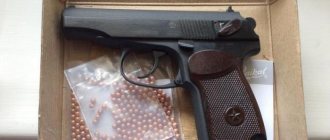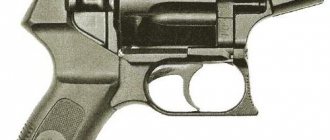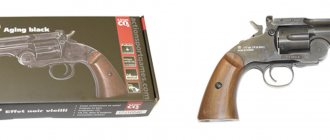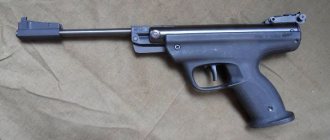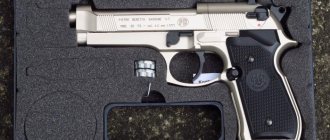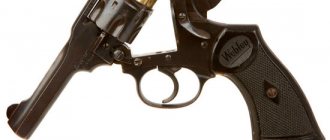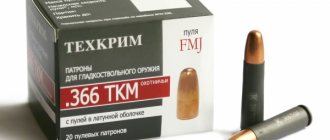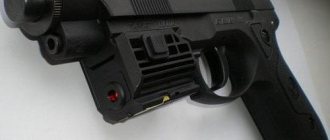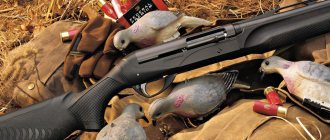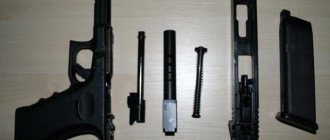There can be many purposes for which pneumatic weapons are purchased. Air pistols and rifles are used as sports equipment in competitions, while others give them preference when hunting small game.
But most often they are just means of spending leisure time. At the same time, the shooter wants to hold in his hand a solid and formidable weapon, which by its very appearance makes friends and foes tremble and respect its owner. That is why a pneumatic revolver appeared on the market, which differs from its firearm counterpart only in lethal force.
The shot is produced by compressed gas
In pneumatic small arms, a bullet is thrown not under the influence of expanding hot gases formed by the explosion of a powder charge, but through the pressure of compressed air or carbon dioxide stored in a container. Depending on the principle of action of the energy source on the trigger mechanism, three types of these weapons are distinguished:
- In a spring-piston type, compressed air is generated due to the movement of a piston driven by a spring when the weapon is broken before firing or by a special lever. One of the subtypes is called multi-compression: air is pumped in several pumps.
- Pre-inflated weapons require air to be pumped into the tank using a compressor before firing.
- The gas cylinder uses carbon dioxide located in a tank or in a replaceable cartridge.
Pneumatic revolvers use a gas-cylinder type of mechanism. As a rule, such samples have a caliber of 4.5 mm (0.177 inches according to Western markings) and a muzzle energy of no more than 3 joules, which implies free sale in the Russian Federation. A pneumatic combat revolver is not suitable for hunting and is intended only for entertainment and sporting events.
Pneumatic analogue of Colt Python
The pneumatic analogue of the Colt Python under the Crosman 357-6 brand has also gained great popularity. The model retained all the visual qualities of the original, but lost a lot in mass. The body is made of silumin - a light alloy of aluminum and silicon; the plastic lining on the handles is removable, thereby opening access to the gas cartridge.
This pneumatic revolver is the most powerful among similar models, which is confirmed by numerous reviews. The shot power reaches 7.5 kJ, which is twice as high as that of competitors. Thanks to its light weight, the weapon is also accurate - the long barrel practically does not outweigh and does not shift the center of gravity. The sound of the shot is also pleasantly surprising.
A distinctive feature is the clip-drum for 10 bullets of 4.5 mm caliber. To reload it, you need to “break” the axis of the receiver. Double-action trigger - the hammer can be cocked either independently or by pressing the trigger.
Pneumatic American Dream
One of the leading manufacturers of air guns is the American company Sport Manufacturing Group (SMG) Inc. The concern offers several dozen types of samples of various price categories, power and design: from exact copies to modern stylish models. The peculiarities of American legislation leave their mark. Different states have their own restrictions on power, some require that gas weapons be painted in colors different from combat ones, or even given a different appearance. In some regions, this type of weapon is generally prohibited. The gunsmiths took into account all the nuances of not only their country, but also the peculiarities of the Eurasian market. The richest range is produced under the Gletcher brand.
Leader in sales in the post-Soviet space
Since 2010, the company has been supplying its products to the CIS countries and Russia. The weapon is specially designed in accordance with domestic legislation. Due to the fact that free circulation of firearms is prohibited in our country, the company undertook an original marketing move. Gletcher products replicate as much as possible the operation of the mechanisms of military analogues: they are made of metal, the movable bolt imitates the shooting of the military original. Since 2011, customers have been offered a series called Russian Legends. All products are guaranteed for one and a half years. The vast majority of gas revolvers on the shelves are Gletcher products.
Weapons of the Russian Empire
In 1895, a revolver of the Belgian Nagant system was adopted by the Russian army. For decades, these weapons were the most popular in our country. SMG offered Russian customers a replica of the legendary revolver. Gletcher NGT Black (“Gletcher” revolver black) was recognized as the most popular gas weapon in 2012. The pneumatic revolver exactly matches its combat prototype in terms of weight and size parameters. The developers tried to ensure that the external similarity was almost one hundred percent. A copy of a revolver compares favorably with other products of the same brand, for example, Smith & Wesson series revolvers (Chinese blanks had American brand logos attached to them).
Gletcher NGT, pneumatic revolver. Performance characteristics
The weapon is made of silumin, the color is radically black, like blued steel. A small batch with silver plating was released. The plastic cheeks of the handle imitate wood and are made of very high quality. The characteristics are as follows:
- Curb weight – 700 g.
- Caliber - 4.5 mm.
- Maximum length - 230 mm.
- The initial speed of the bullet is 120 m/s.
- Muzzle energy – 3 joules.
- Magazine capacity – 7 rounds.
- Ammunition type: steel shot.
- The energy source is a CO2 reservoir.
Types of pneumatic revolvers by type of projectile
Structurally, almost all pneumatic revolvers are exact copies of their firearm counterparts. Some species even have the same weight. A cylinder with compressed carbon dioxide is hidden in the handle; the drum is most often loaded directly with 4.5 mm bullets.
Some models use false cartridges for charging - metal cartridges that imitate a live cartridge. They have an internal cavity into which the bullet is installed, as well as plastic linings that improve the tightness. After shooting, a metal ball must be inserted into such a false cartridge, after which it is again ready for shooting.
But most often a pneumatic revolver uses metal bullets of 4.5 or 5.5 mm caliber as projectiles. Types of weapons with such ammunition are quite common due to their relatively low cost. But you shouldn’t expect high realism from them.
Action of the mechanism
The Gletcher pneumatic revolver reproduces a firearm revolver as closely as possible. The trigger mechanism allows firing both by self-cocking and with manual pre-cocking of the hammer. It differs from the original in that the drum is stationary during the shot, that is, it does not slide along the barrel, but the barrel itself is spring-loaded. This was done for more effective sealing and to prevent gas breakthrough during firing. As on the combat counterpart, the drum is removed from the frame. There is a manual safety on the body that blocks the hammer and trigger.
Revolvers of the world
Home | Weapons | Revolvers
This section contains detailed information about the history of creation, design, distinctive features, technical characteristics, advantages and disadvantages, as well as aspects of the practical use of revolvers in the world.
- Belgium
- Brazil
- Great Britain
- Germany
- Spain
- Italy
- Russia/USSR
- USA
- France
- Czech
A revolver is a multi-shot melee firearm, the cartridges of which are fed using a rotating cylinder (drum), in the chambers of which the cartridges are located; when fired, the barrel of the revolver is a continuation of the next chamber of the drum.
Basically, a revolver drum has a capacity of 5 to 7 rounds, both 9-mm and larger and small-caliber, but the drums of 5.6-mm revolvers can hold about 10 rounds. Reloading of a revolver is carried out, as a rule, either one cartridge at a time (for example, a Nagant revolver) in relation to most designs of the 19th century, or by simultaneous extraction using a drum or turning frame that folds to the side. Removing spent cartridges in modern revolvers is carried out using an extractor by pressing its rod after the drum has been tilted to the side. This removes all spent cartridges at the same time. In order for unfired cartridges to remain in the drum and spent cartridges to be thrown out, the extractor stroke is selected accordingly. Revolvers with folding cylinders can be loaded using special clips (“speedloaders”).
Revolvers are equipped with two main types of trigger mechanism - single action (Single Action) and double action (Double Action).
Most modern revolvers are equipped with double-action, self-cocking trigger mechanisms, which allows you to fire the first shot by simply pulling the trigger, without the need to pre-cock the hammer. The trigger can be pre-cocked for a more accurate shot. When firing from a revolver with a double-action trigger, for the first and all subsequent shots, the hammer is cocked by the shooter’s muscular force when the trigger is pressed, and the drum at this moment rotates, bringing the next chamber to the barrel. The double-action trigger allows you to increase the rate of fire and makes shooting easier, but at the same time it significantly increases the force required for triggering. The trigger force for single-action revolvers ranges from 1 to 2 kg; for double-action revolvers, when firing by self-cocking, the force ranges from 5 to 6 kg. and more.
The single-action trigger mechanism allows the revolver to be fired in only one way - by cocking the hammer each time before firing. This type of trigger was used in many revolvers of the 19th century and continues to be used in modern replicas of ancient models. Shooting with pre-cocking improves shooting accuracy, but reduces the rate of fire.
Currently, only self-cocking firing mechanisms have gained widespread popularity, in which the hammer or striker is cocked solely by pressing the trigger.
Weapons with a rotating block of charging chambers (drum) have existed since the end of the 16th century. These were examples with a matchlock or flintlock. In them, the drum simultaneously plays the role of a chamber and a magazine for charges. But since manufacturing a high-quality drum mechanism by hand was expensive and required a lot of effort and time, revolver weapons did not gain mass popularity in those days, remaining only an expensive exotic. A second chance for weapons with a rotating block of charging chambers was given by the invention of the capsule, which made relatively fast shooting possible, and the advent of machine production, which reduced the cost of manufacturing complex mechanisms. In the USA, in 1836, Samuel Colt opened the first factory in Paterson for the mass production of capsule revolvers of his own design. It was this event that became a turning point in the history of revolvers, bringing these weapons to a new level of quality, efficiency and popularity.
The first revolvers were muzzle-loading - gunpowder and a bullet were loaded into each chamber at the front. Sometimes the revolver was supplemented with a lever that made it possible to press a bullet into the chamber of the drum. Each chamber had its own fire tube for the capsule. Loading a capsule revolver was a labor-intensive process, and some designs allowed for quick replacement of the drum, so that the owner of the revolver could quickly replace the drum with a loaded one if necessary. Thus, the revolver drum is both the chamber and the magazine at the same time. Later, revolvers chambered for a unitary cartridge also appeared. The term “unitary cartridge” means that the bullet, buckshot or shot charge, powder charge and igniter primer are connected into one whole by means of a cartridge case.
The first revolvers chambered for this cartridge, invented by the German gunsmith Dreyse in 1836, worked as follows: the cylinder axis was removed and the drum was removed. Later, recesses for loading began to be made in the cover covering the drum on the back side. The spent cartridges were removed one at a time through the same recess, for which it was necessary to move a special rod back. Soon a different design appeared - a break-in revolver, the frame of which is broken on a hinge, like the barrels in hunting rifles, thereby opening access to the drum. Many break-in revolvers are equipped with an automatic extractor that ejects all spent cartridges when the frame is opened. The disadvantage of this type of revolver is that the hinge and lock wear out over time and the frame becomes loose. Currently, the most proven method of reloading a revolver is used - a side-folding drum.
Most revolvers do not have a safety mechanism that is controlled by the shooter. Some models of revolvers have automatic hand-operated safeties - the safety key is pressed with the palm of the shooter's hand when grasping the handle of the revolver, which causes the constantly on safety to be switched to the off position and shooting becomes possible. In modern revolvers, other methods are adopted to ensure safety: the firing pin is made separately from the trigger; when the trigger is not pulled, a special part prevents the firing pin from coming into contact with the cartridge primer; triggers with a “release” are used, that is, the released trigger stops at some distance from the extreme forward position and can move further forward and break the primer only when the trigger is pressed. As many years of practice have shown, such devices are quite sufficient to protect the shooter, eliminating the possibility of an accidental shot even with the hammer cocked.
Automatic revolvers use recoil energy to cock the hammer and turn the cylinder. Automatic revolvers have not become popular due to the fact that, with a slight advantage in rate of fire over traditional revolvers, they combine the disadvantages of both revolvers and self-loading pistols.
The disadvantages of a revolver include the gap between the cylinder and the barrel, through which some of the powder gases break through when fired, and a certain amount of muzzle energy is lost. In addition, due to this feature, a silencer is rarely used in conjunction with revolvers, even when firing cartridges with a subsonic muzzle velocity, since even when using PBS, a loud sound is heard caused by the breakthrough of powder gases into this gap. However, with some types of revolvers, PBS can still be used effectively. Some revolver models allow the effective use of a silencer. Such a revolver is the Nagan model 1895, which has a powder gas obturation design, for which the Bramit silent-flameless firing device was produced in the USSR in the 1930s. According to some information, during the participation of the USSR in World War II, Nagant revolvers with “Bramites” were used both by reconnaissance and sabotage units of the Red Army and the NKVD, and by the enemy during special operations. In addition, in the USA, for the Tunnel Rats, AAI modified the Smith & Wesson Model 29 revolver, which was subsequently designated Quiet Special Purpose Revolver (QSPR). Quiet shooting from this weapon was achieved not by using a silencer, but by using a specially designed cartridge with the powder gases locked inside the cartridge case. A similar solution was used in the PSS silent self-loading pistol.
The main advantages of revolvers are: high reliability, limited only by the reliability of the cartridges used; long service life; safety in handling; spent cartridges remain in the drum and do not fly out automatically, so they cannot hit the shooter, as happens when using pistols; the ability to use low-power cartridges, for example, a .357 caliber revolver can fire .38 Special cartridges; simplicity of design; ease of maintenance. Main disadvantages: significantly smaller drum capacity than the capacity of self-loading pistol magazines; Reloading a revolver drum usually takes longer than changing a pistol magazine; rate of fire lower than that of self-loading pistols; less accuracy of high-speed shooting by self-cocking than accuracy of high-speed shooting from pistols when their hammer or firing pin is cocked automatically; large dimensions and weight; hot gases bursting between the drum and the barrel with an incorrect grip or position of the weapon can cause burns to the shooter’s fingers.
Currently, despite all their shortcomings, revolvers continue to enjoy a certain popularity, since often the decisive factors when choosing a weapon are its minimum readiness time for the first shot, ease of use and reliability.
The now popular compact five-shot revolvers, with 51 mm / 2 inch barrels, chambered for the .357 Magnum cartridge are ideal for concealed carry for self-defense or as a backup weapon due to the combination of small dimensions and weight with the high stopping power of the bullet of the cartridge used. This class of revolvers is the most popular at the moment and, most likely, will be the most popular in the future. In addition to the qualities of the revolvers themselves, the arms market currently offers many very useful accessories, such as fiber optic front sights and rubber grip cheeks with a built-in laser designator.
Revolvers
- Spain
- USA
- Great Britain
- Germany
- France
- Belgium
- Italy
- Russia/USSR
- Brazil
- Czech
Equipment with cartridges
Metal shot coated with a layer of copper is used as ammunition. To prepare for shooting, bullets should be secured in false cartridges. The NGT pneumatic revolver uses original ammunition, other models will not work. The loading procedure is the same as the original: cartridges are inserted one at a time into the drum while rotating clockwise, just like a real firearm. When loading a cartridge, the bullet must be immersed until it makes a characteristic click. The recessed shot should be flush with the rubber pad. The peculiarity of the false cartridges is that two rubber inserts are pressed into them: in the front part and at the end. This ensures minimal gas losses. The drum mechanism is not folding. The gas cylinder is placed in the handle and covered with a plastic cover. The clamping screw is disguised as a trench coat.
Shooting from a pneumatic revolver
The gas reserve in one cylinder is enough for 105 shots (15 loaded drums). This figure is significantly higher than that of other similar products. Over the course of 60 shots, the bullet flight speed of 120 m/s declared by the manufacturer is maintained, and then the indicators drop to 85 m/s and below. We are talking about using a spherical explosive bullet. The self-cocking trigger force is about 3 kg, three times lighter than the analogue, which is very comfortable to use and has a positive effect on shooting accuracy. Accuracy is within normal limits for this type of small arms.
Borner revolvers
The leading manufacturer specializing in air guns is the American company Central Bornership Company (CBC) Inc. The products are manufactured under the Borner brand. The company entered the domestic market in 2011. The high quality of the products is evidenced by the fact that Gletcher and Crosman acquire licenses for the production of some samples. The flagship line of revolvers is represented by three smooth-bore models with similar parameters:
- Pneumatic revolver Borner Super Sport 708: weight - 1020 g, drum capacity - 6 cartridges for explosive bullets, initial bullet speed - 120 m/s, prototype - Smith & Wesson in the Military Police version. It is possible to install a collimator or optical sight.
- Super Sport 703 is a very powerful pneumatic revolver: weight - 1040 g, drum capacity - 6 explosive bullets, bullet flight speed - up to 135 m/s, barrel length - 8 inches (203 mm), does not have a combat prototype. The design allows for the installation of sights. Very convenient for aimed shooting.
- Super Sport 705: weight - 650 g, flight speed - up to 130 m/s, drum capacity - 8 explosive bullets, barrel length - 4 inches (102 mm). The appearance is stylized to match the dimensions of the Smith & Wesson model. The developers have provided for the installation of a collimator or optical sight.
Also popular are the eight-shot Super Sport 705 (weight - 700 g, six-inch barrel), the six-shot 702 model weighing 900 g. All samples include the use of false cartridges and are equipped with a drum tilting mechanism.
Air pistols and revolvers
You can buy air guns, including pistols and revolvers, without a license or permit—you don’t even have to be of age. They occupy a leading position among other offers for the sale of weapons of various types and purposes. Most often, air pistols and revolvers are purchased for personal use or as a gift. In any case, you need to understand their purpose. Weapons from this section are used for entertainment and training purposes, and can be used as a dummy during filming. They are not suitable for hunting purposes, as they have low power - about 3 J, which is more suitable for targeted shooting from a distance of no more than 20 meters. Air pistols and revolvers fire using compressed gas, bullets or pellets. If shot accuracy is important, buy bullets. Balls cause more damage, so they are not particularly suitable for entertainment and training purposes. Please note that bullets can only be fired from air pistols with a rifled barrel. From the presented types of pneumatics, you can choose spring-piston, gas-cylinder or with a pre-inflation cylinder (PCP). Air pistols and revolvers with a spring-piston mechanism work by compressing air with a piston at the moment of firing. The piston cylinder is driven by a gas or coil spring. Since the power of the former is greater, it is mainly used in rifle designs. Gas-cylinder mechanisms use carbon dioxide cylinders to launch projectiles. Here you can buy modern pistols and revolvers with CO2 weighing 12 grams. It accelerates bullets to a speed of 100–120 m/s. To empty the cylinder you will need to fire 50–70 shots. The mechanisms of PCP pistols and revolvers also use large reservoir cylinders with compressed air. The main advantage is the larger number of shots compared to the previous version - 200–250. In addition, such cylinders are easy to refill yourself. Air pistols and revolvers from manufacturers from Denmark, France, USA, Spain, Germany and Russia will create the feeling of a real weapon in your hands. This section presents a wide range of well-known models ASG, Stalker, Cybergun, Gletcher and others. Ammunition is usually looked at along with pistols and revolvers. If the future owner has preferences regarding the choice of lead bullets or steel balls, you can focus on them when selecting a weapon. Balls are never used for air pistols and revolvers with rifled barrels, as they can damage them. But bullets are not taken for weapons with a smooth barrel, so as not to lose the advantages of accuracy. Worries about the possibility of causing discomfort to others due to loud shots are in vain; the sound does not exceed 80–90 dB, which means it is relatively quiet. At the same time, you must always remember and follow safety precautions. To buy an air gun, you just need to choose the appropriate model yourself or call the manager for advice. After confirmation, you can receive your order at the specified address or via self-pickup.
Rifled brothers
A type of weapon that uses the kinetic energy of expanding cold gases to fire is a rifled pneumatic revolver. The rifled barrel provides greater accuracy and accuracy of fire. In this niche, Gletcher offers a replica of one of the models of the famous Smith & Wesson revolver. The model is called Gletcher SW R6, in the basic version it is equipped with a rifled barrel made by German Lothar Walther. The owners note a fairly accurate imitation of the execution and the realism of the shooting process. The folding drum completes this effect. The flight speed of a steel bullet is 120 m/s. However, the use is slightly overshadowed by the need for additional equipment for false cartridges: a round steel bullet must be removed and a lead one inserted. Samples with a Umarex barrel have a higher cost.
It should be said that rifled weapons are very expensive. Not all leading brands have similar pneumatic revolvers in their product range. The most powerful representative of this class is the Vigilante from the Crosman weapons company. Model 357-6 does not have a combat prototype, but is vaguely reminiscent of the firearm Stealth Hunter from the same Smith & Wesson company. The manufacturer states that when firing explosive ammunition, the bullet's flight speed is 140 m/s. This revolver is omnivorous: a 10-round drum is designed for firing lead bullets, and a 6-round drum for shooting pellets. True, not the whole drum, but its moving segment. The 6-inch (152 mm) barrel contributes to high shooting accuracy.
Pneumatic pistols cal.4.5mm
4.5mm air pistols are a subtype of weapon in which a bullet (ball) is fired under the influence of carbon dioxide or pressurized air. The main purpose is recreational shooting at bottles and targets in nature and training in initial shooting skills. In addition, in emergency cases, you can use a gun for self-defense to scare a bully, but there are different opinions regarding the effectiveness of this.
You can buy an air pistol at the Sniper Store in Perm
Air pistols are a subtype of weapon in which a bullet (ball) is fired under the influence of carbon dioxide or pressurized air. The main purpose is recreational shooting at bottles and targets in nature and training in initial shooting skills. In addition, in emergency cases, you can use a gun for self-defense to scare a bully, but there are different opinions regarding the effectiveness of this.
Many men, as well as some women, want to have at their disposal a beautiful replica of a real weapon. Maintaining a traumatic weapon can be financially expensive; in this case, pistols come to the rescue, as they are the most popular among all pneumatics. The initial velocity of a projectile is usually 110-120 meters per second. The price of air pistols starts from 2-3 thousand rubles.
According to the law of the Russian Federation, pistols of 4.5 mm caliber and muzzle energy up to 3 J are not weapons, but belong to products structurally similar to weapons
and are intended for initial shooting training and recreational shooting. The pistol can be safely stored and carried with you, having a certificate.
Types of pistols by mechanism of action
According to the principle of operation, guns are divided into: spring-piston, gas-cylinder and compression.
The first type (spring-piston) is familiar to most people from childhood. It is on this principle that all rifles in shooting ranges work. The shot is fired due to the movement of the piston under the action of a spring that was previously compressed. The simplest in design, prominent representatives: Gamo P-900, IZH-53M, Umarex Browning Buck Mark URX
Gas pistols receive energy from a special cylinder containing liquefied carbon dioxide. When firing a shot, the dispenser releases a portion of carbon dioxide into the barrel, which then accelerates the bullet. Such a weapon allows you to fire about 50-70 full shots until the gas runs out. The most common type. For example: Gletcher BRT 92FS Auto
The third type of pistols (compression) is somewhat different from the previous ones. Air is pumped into a special reservoir, usually located in the butt or in the handle, which creates the pressure necessary for firing. A special pump is used to pump air. To shoot, you will need to make 10-15 pump strokes, but one may be enough. There are very few such pistols, since such a mechanism is used mainly in rifles and shotguns.
Crosman 1377 C is a bright representative of the American classics. Has a lightweight cocking mechanism. To shoot, you will need to make about 3-10 pumping motions.
Pneumatic copies of famous combat pistols
Among the pistols there are often copies of their military relatives. Such models often have the same weight and trigger mechanism (trigger mechanism), and also repeat the main details. Popular copies of gas pistols include the following:
The domestic Izhevsk MP-654K is similar in appearance to a Makarov pistol. It has a steel rifled barrel and a very reasonable price. There are also many pistols that copy PM, imported, such as: Gletcher PM, Borner PM49, Swiss Arms Makarov, Umarex PM Ultra, Smersh H1.
MP-655K is a copy of Yarygin’s pistol. Has a magazine for 100 charges. There is also Gletcher Grach NBB.
Crosman C-TT, Gletcher TT NBB imitate the popular TT pistol.
Copies of Stechkin pistols (APS), Beretta, Colt, Parabellum, Walter, etc. are quite popular.
How to choose an air gun
Having decided on the operating principle of your pistol, pay attention to the following characteristics:
— case material: plastic, nickel or metal alloy;
— pistol or revolver, barrel length, model weight;
— Blowback function, simulating combat analogues: moving shutter when firing
— features of the trigger mechanism, the initial speed of the bullet;
— additional rails for installing a laser sight, sight or tactical flashlight.
Which revolver is the most powerful?
To summarize, we can say that the products of different companies are almost identical. The same energy source is used, the same ammunition is used, and the mechanical parts are similar. The only difference is in the quality of execution and external design. The most powerful models are those with a barrel length of 8 inches (203 mm). As a rule, for these samples the initial bullet speed reaches 140 m/s, while the standard speed stated in the passport is 120. In these indicators, gas-cylinder weapons are significantly inferior to spring-fracture weapons and those with pre-pumping, in which the bullet speed reaches 210 m/s and even more, and the muzzle energy is the maximum permissible by law 7.5 joules. The record holder is Zoraki Hp-01 Light - a Turkish air pistol. The revolver does not appear on these lists. And not only due to its design features, which do not allow one to disguise the bulky piston mechanism. These weapons serve other purposes, primarily aesthetic ones. In ballistic terms, an air revolver is inferior to a pistol.
ME revolvers
Most often, pneumatic pistols and revolvers operate using the energy released from compressed carbon dioxide. There are also spring-piston and PCP models. But there are also rarer examples of short-barreled weapons that use air cartridges. In fact, revolvers of this type (it is the revolvers that dominate this class of pneumatics) represent the PCP class, but the compressed air is not in the tank, but in false cartridges.
The ME 38 Magnum-4.5D revolver is a classic example of the above-described class of pneumatic weapons. This revolver is produced by the German company Cuno Melcher. The company, by the way, in Russia is known not only for pneumatic, but also for traumatic ME weapons. The revolver receives air energy according to the so-called LEP principle (Luft-Energie-Patrone), which translated from German means powered by air from a cartridge. This system was not widely used; high cost and a number of operational features prevented revolvers of this type from becoming widespread. However, the ME company still produces several models of pneumatic revolvers which, unfortunately, are not officially supplied to Russia.
ME 38 Magnum-4.5D
Performance characteristics of the ME 38 Magnum-4.5D revolver:
Caliber: 4.5 mm (.177)
Length, mm: 210 Weight, kg: 0.625
Drum capacity: 5 cartridges
Operating pressure in the cartridge - up to 200 bar Maximum pressure in the cartridge - 230 bar Barrel length - 80 mm Muzzle velocity with 4 pumps (real) - 135 m/s Muzzle velocity with 8 pumps (real) - 145 m /s Required number of pumping motions - from 3 to 8
Trigger force with self-cocking is 10-11 kg, with pre-cocking - 2.5 kg.
The ME 38 Magnum-4.5D revolver resembles Ruger & Co. in appearance. mod. GP-100, but does not copy it. Interestingly, the company produces a range of revolvers with different designs. These are nickel plated and blued, as well as for different markets around the world. So, for those countries where the legislative framework for pneumatics is strict, the revolver was produced with a sawn-through drum, to prevent it from being equipped with live cartridges. Moreover, in addition to models for 4.5 mm caliber, ME also produces revolvers for the “papal” 5.5 mm caliber.
Ruger & Co. mod. GP-100
The design of the revolver is very simple. The drum tilts to the left, double-action trigger, rear sight adjustable vertically and horizontally, rifled barrel with 12 rifling. All the fun stuff is in the cartridge cartridge. Thus, each cartridge is a miniature PCP system with an air reservoir and valve. It consists of 2 detachable parts. A lead bullet is inserted into one of the parts (imitation bullet), and the other (imitation cartridge case) contains the entire “air system”. The parts are connected together using threads. To load such a cartridge, you first need to unscrew the top part, then attach it to the pump or charging station, make the required number of pumps, then disconnect the cartridge, insert the bullet into the top part, and attach it to the main one. Moreover, the speed of the bullet will depend on the amount of air filled. The revolver manual recommends making no more than 8 pumping strokes for one cartridge.
Option with sawn and whole drum
Explosion diagram
Aircartridges
The resource of each cartridge, as stated by the developers of the ME company, is designed for at least 1000 shots. Moreover, after maintenance (changing the rubber sealing rings), the cartridge is again ready to “work” a thousand more times. To prevent the possibility of converting the revolver into a combat one, in models with an undissolved cylinder, cuts were made in the chambers.
Air cartridge device
Hand pump
Currently, you can buy such a revolver by ordering it from abroad, or in Russia, which is called “from hand”. The price tag is quite high, but this is understandable, the quality is German, and the design of the cartridges is quite complex.
ME Bull-Barrel
ME Competition 6
